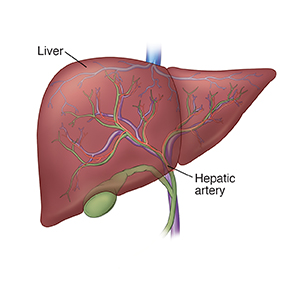Chemoembolization for Liver Cancer: The Procedure
Chemoembolization is a way to treat cancer in the liver. It can be used for cancer that starts in the liver. Or it can be used for cancer that has spread (metastasized) to the liver from other parts of the body. The procedure treats cancer only in the liver. It is done by a specially trained healthcare provider (interventional radiologist).
How does chemoembolization work?
The hepatic artery is a large blood vessel. It sends blood to the liver. To grow, a liver tumor takes most of its blood from this artery. During the procedure, chemotherapy medicines are put into the hepatic artery. The artery is then blocked off from the rest of the body. This makes sure the medicines stay in the liver. And it cuts off blood to the tumor.

The goals of chemoembolization
-
Block the tumor’s blood flow so it gets no oxygen or nutrients.
-
Send high doses of chemotherapy medicines right to the tumor site.
-
Keep the medicines in the tumor for long periods of time.
-
Reduce side effects to the rest of the body. This is because the medicines don't leave the liver.
Getting ready for the procedure
-
Follow any directions you are given for not eating or drinking before the procedure.
-
Tell your healthcare provider about all your health conditions.
-
Tell your provider about all the medicines you take. This includes all prescription and over-the-counter medicines. It also includes vitamins, herbs, supplements, and illegal drugs. You may be told to stop taking some medicines before the procedure.
During the procedure
When you arrive for the procedure, an IV (intravenous) line will be put into your arm. This IV will give you fluids and medicine to get your body ready for the procedure. This preparation may take several hours. To start the procedure:
-
The healthcare provider puts a long, flexible tube (catheter) into an artery in your groin.
-
The provider puts an X-ray dye (contrast medium) through the catheter. This helps the artery and catheter show up better on X-rays. The provider can see the catheter's movement on a video screen.
-
The provider guides the catheter to the hepatic artery in the liver. They then move it to the tumor.
-
The provider injects the chemoembolization medicines through the catheter. They then inject a substance that blocks the artery.
-
The catheter is taken out. The provider puts pressure on the insertion site for 15 minutes. This is to prevent bleeding.
-
You will lie flat for several hours. During this time, the IV line will give you fluids. You will likely stay in the hospital for a few days after the procedure.
Side effects of chemoembolization
Side effects include tiredness, belly pain, fever, nausea, and loss of appetite. These may last for several days. Medicines can help reduce certain side effects.
Possible risks
-
Blood clot in a blood vessel
-
Infection or bruising where the catheter was put in
-
Death of normal liver tissue, which may lead to liver failure
-
Damage to the gallbladder or other nearby organs
-
Problems because of the X-ray dye, such as an allergic reaction or kidney damage
-
Damage to an artery
-
Death
Online Medical Reviewer:
Neil Grossman MD
Online Medical Reviewer:
Raymond Turley Jr PA-C
Online Medical Reviewer:
Tara Novick BSN MSN
Date Last Reviewed:
7/1/2022
© 2000-2025 The StayWell Company, LLC. All rights reserved. This information is not intended as a substitute for professional medical care. Always follow your healthcare professional's instructions.